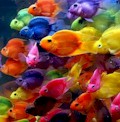An Aquarium filter is a required device for both freshwater and marine aquaria, and are very important for maintaining high water quality in your fish tank. Aquarium Filters can be either internal or external to the aquarium, external filters are sometimes called HOB’s or hang on back. A filter will process fish waste, unconsumed food and other particulates, some filters can even filter down to the micron level. Filters are available in a wide variety of sizes and styles to work with any type or size aquarium you choose. Below are some of the most common filter styles used today.
Power FiltersPower filters are the most common and popular filter for most aquarium enthusiasts. They are easy to set up, require very little maintenance and are inexpensive which makes them a good choice for the new hobbyist. Many times power filters are used together with an under gravel filter for increased water purity.
The filter works by drawing the water through the filter media under slight pressure and forcing it back into the tank. An aerator is not usually needed when using a power filter since it provides enough water movement during filtration to keep the tank oxygenated.
Sponge FiltersSponge filters are most commonly used in breeding tanks to keep small fish from entering the filter and are appropriate only for very small aquariums. Sponge filters use an internal form of biological filtration to keep the aquarium water clean and safe for your tropical fish. Aerobic bacteria will grow on the filter’s sponge helping to facilitate the tanks nitrogen cycle. Extra care should be used when cleaning a sponge filter so as not to wash away the nitrifying bacteria.
Under Gravel FiltersUnder gravel filters, also referred to as UGF are another popular type of aquarium filter that you can use for your fish tank. Under gravel filters are one of the more regularly used styles of fish tank filters due to its large area for biological filtration.
Under gravel filters are comprised of a porous plate which is placed an inch or two under the gravel substrate with one or more uplift tubes and an aerator. The UGF is a type of biological filter that draws the water through the substrate material and then returns it at the top of the tank.
The only drawbacks to this type of filter is that the fish waste tends to get pulled down into the gravel which requires regular vacuuming and live plants do not grow well planted over a UGF. Under gravel filters are sometimes paired with a power filter to provide extra filtration for the aquarium.
Canister FiltersOne of the best filtration choices for any aquarium set up is a Canister Filter. Canister filters contain an internal pump connected to a sealed container where waste from the water is trapped for removal. A canister filter is an ideal choice for filtering large aquariums that contain many fish, or fish that create a lot of waste like large tropical fish or goldfish. Canister filters don’t provide much aeration so bubble stones are recommended to help bring oxygen into the tank. Canister filters are great but are usually more expensive than ordinary hang on tank type filters.
Diatom FiltersDiatom filters are primarily used for occasional cleaning of tanks, and are not constantly connected to the aquarium. Diatom Filters are extremely efficient and are designed to mechanically filter out the smallest of particles all the way down into the 1 micron size range. Aquarium diatom filters also help with “sick tanks” encouraging quicker fish healing by removing organics and other parasites. They are also excellent for removing algae blooms and clean your tanks water to an incredibly pure state.

